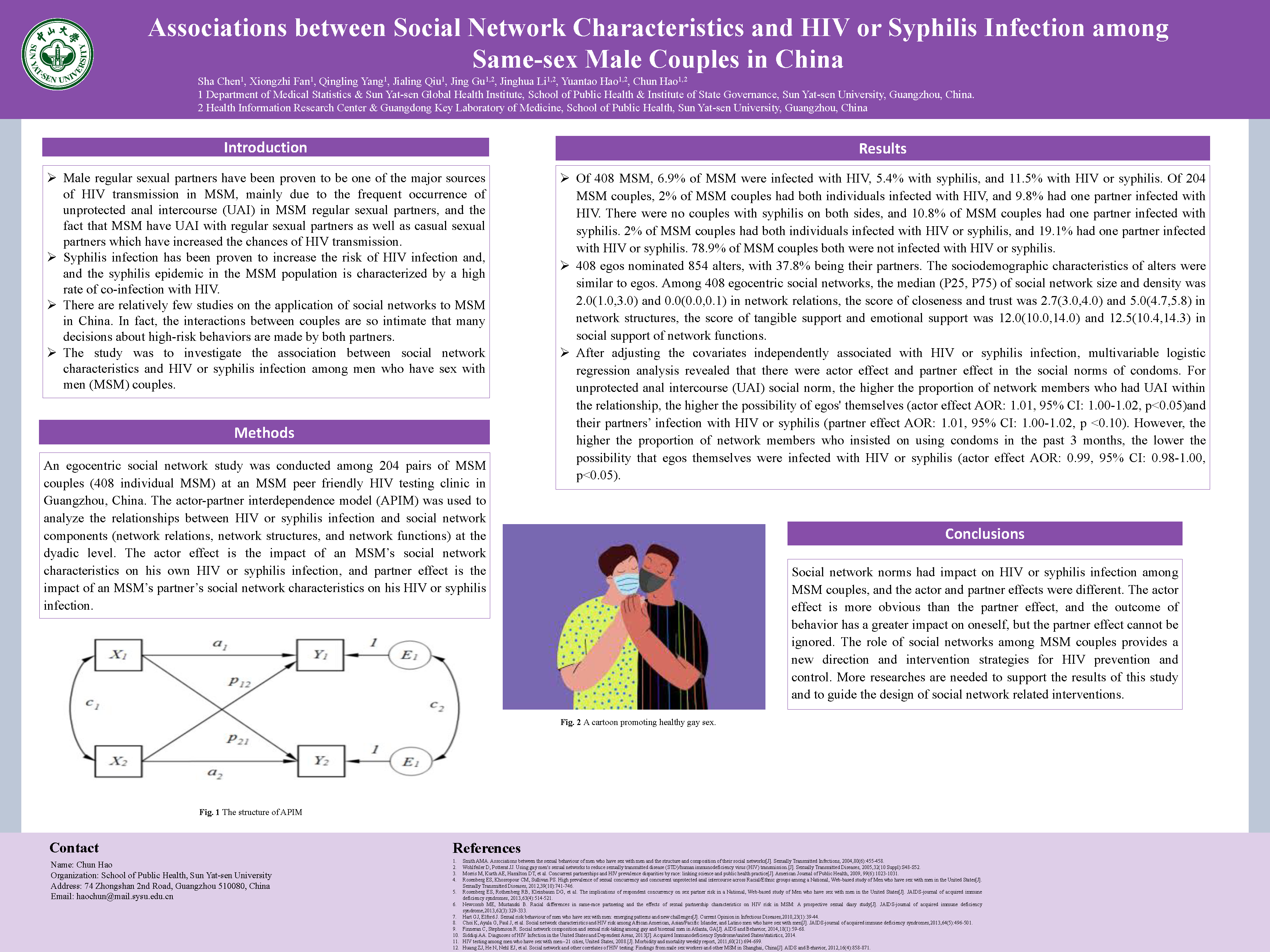
Associations between Social Network Characteristics and HIV or Syphilis Infection among Same-sex Male Couples in China
Sha Chen, Xiongzhi Fan, Qingling Yang, Jialing Qiu, Jing Gu, Jinghua Li, Yuantao Hao, Chun Hao
Objective: To investigate the association between social network characteristics and HIV or syphilis infection among men who have sex with men (MSM) couples.
Methods: An egocentric social network study was conducted among 204 pairs of MSM couples (408 individual MSM) at an MSM peer friendly HIV testing clinic in Guangzhou, China. The actor-partner interdependence model (APIM) was used to analyze the relationships between HIV or syphilis infection and social network components (network relations, network structures, and network functions) at the dyadic level. Actor effect is the impact of a MSM’s social network characteristics on his own HIV or syphilis infection, and partner effect is the impact of a MSM’s partner’s social network characteristics on his HIV or syphilis infection.
Results: Of 408 MSM, 6.9% of MSM were infected with HIV, 5.4% with syphilis, and 11.5% with HIV or syphilis. Of 204 MSM couples, 2% of MSM couples had both individuals infected with HIV, and 9.8% had one partner infected with HIV. There were no couples with syphilis on both sides, and 10.8% of MSM couples had one partner infected with syphilis. 2% of MSM couples had both individuals infected with HIV or syphilis, and 19.1% had one partner infected with HIV or syphilis. 78.9% of MSM couples both were not infected with HIV or syphilis. 408 egos nominated 854 alters, with 37.8% being their partners. The sociodemographic characteristics of alters were similar to egos. Among 408 egocentric social networks, the median (P25, P75) of social network size and density was 2.0(1.0,3.0) and 0.0(0.0,0.1) in network relations, the score of closeness and trust was 2.7(3.0,4.0) and 5.0(4.7,5.8) in network structures, the score of tangible support and emotional support was 12.0(10.0,14.0) and 12.5(10.4,14.3) in social support of network functions. After adjusting the covariates independently associated with HIV or syphilis infection, multivariable logistic regression analysis revealed that there were actor effect and partner effect in the social norms of condoms. For unprotected anal intercourse (UAI) social norm, the higher the proportion of network members who had UAI within the relationship, the higher the possibility of egos' themselves (actor effect AOR: 1.01, 95% CI: 1.00-1.02, p<0.05)and their partners’ infection with HIV or syphilis (partner effect AOR: 1.01, 95% CI: 1.00-1.02, p <0.10). However, the higher the proportion of network members who insisted on using condoms in the past 3 months, the lower the possibility that egos themselves were infected with HIV or syphilis (actor effect AOR: 0.99, 95% CI: 0.98-1.00, p<0.05).
Conclusions: Social network norms had impact on HIV or syphilis infection among MSM couples, and the actor and partner effects were different. The actor effect is more obvious than the partner effect, and the outcome of behavior has a greater impact on oneself, but the partner effect cannot be ignored. The role of social networks among MSM couples provides a new direction and intervention strategies for HIV prevention and control. More researches are needed to support the results of this study and to guide the design of social network related interventions. 
← Schedule

